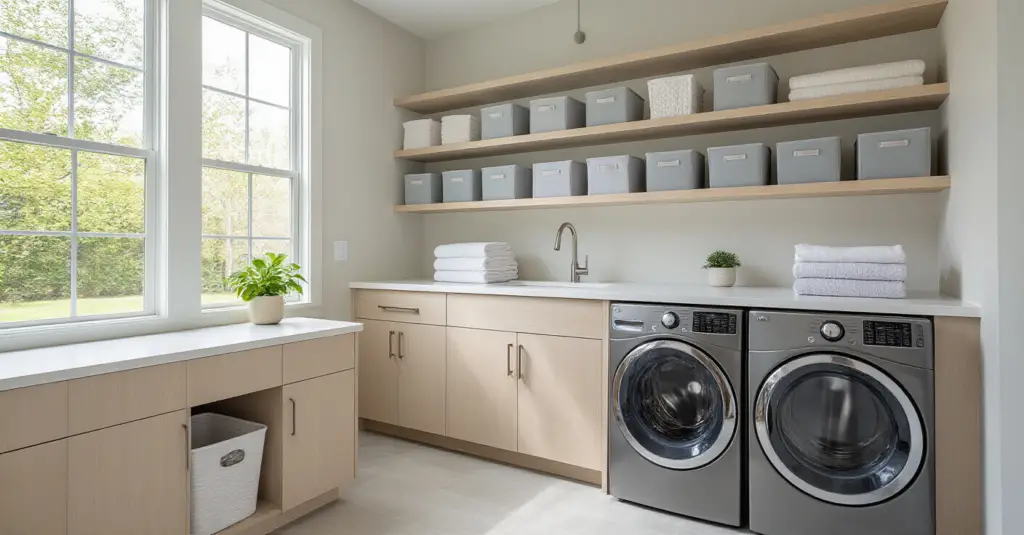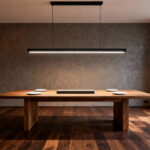Picture this: The party is epic. The game is on your 8K screen, the sound system is perfectly calibrated, and everyone is having an amazing time. Then it happens. Someone spills a glass of red wine on your beautiful cream-colored rug. No problem, you’re a pro host. But as you open the door to the laundry room to grab the stain remover, a wave of chaotic energy—and a mountain of unfolded clothes—spills out into the hallway, killing the vibe instantly.
We spend so much time perfecting the “front stage” of our homes—the living rooms, the kitchens, the home theaters. But we completely forget that the “backstage”—the utility spaces—is what keeps the whole show running smoothly. Your laundry room isn’t just a place for chores. It’s the command center for your home’s hospitality. An inefficient, cluttered, and ugly laundry room is a source of stress that pulls you away from what really matters: connecting with your friends and family. Let’s fix that.
Smart Planning & Space Optimization Foundations (Part 1)
This is ground zero. Before you buy a single appliance or cabinet, you need a strategy. Think of this as laying the fiber optic cable before you install the router. Getting the foundations right means everything else will work seamlessly, saving you headaches and money down the line. It’s about designing a system that works for you, not the other way around.
1. Conduct a Workflow Audit: Analyze Your Laundry Habits
Before you can fix a system, you have to find the bugs. A “workflow audit” sounds corporate, but it’s just you figuring out where the bottlenecks are in your laundry process. Why is there always a pile of clean clothes on the floor? Why does it take you ten minutes just to find the stain stick? This isn’t about doing laundry better; it’s about designing a space where the process is so smooth, you don’t even have to think about it.
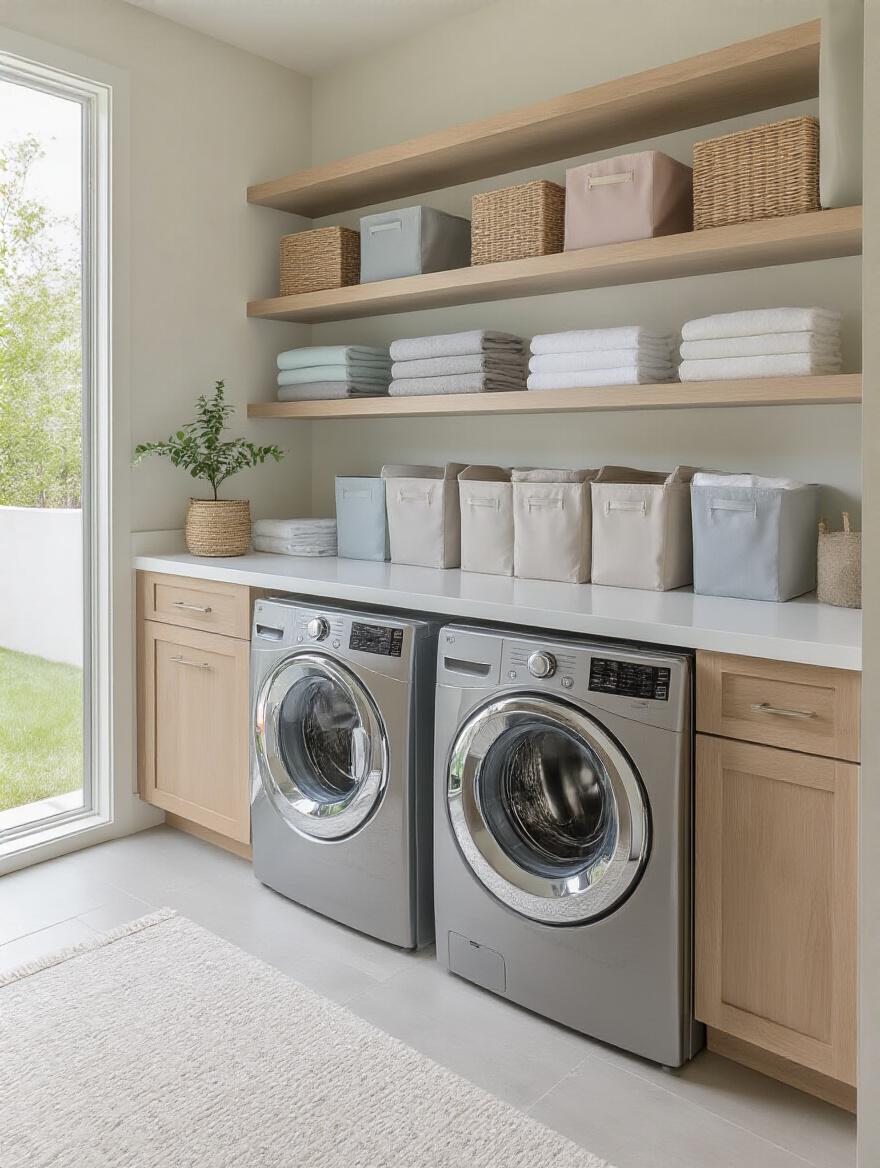
I had a client who threw amazing Super Bowl parties, but he’d spend half the game stressed because the laundry from his weekend guests was piling up in a chaotic back room. We audited his process and realized he was making five trips between the basement laundry, the main floor linen closet, and the upstairs bedrooms for every single load. The real issue wasn’t the laundry; it was the terrible logistics. By redesigning the flow and storage in one place, we turned his “room of dread” into a silent, efficient engine that let him get back to the party.
Think about the path your laundry takes from hamper to closet. Your goal is to shorten that path and remove every single point of friction.
2. Define Your Laundry Room’s Multi-Purpose Functionality
Everyone says a laundry room can be a “multi-purpose” space, which is usually code for “a dumping ground for everything that doesn’t have a home.” That’s noise. What really matters is defining its supporting functions. Does it need to be a mudroom to handle coats and muddy boots after a big tailgate? A pet station for washing the dog after a day at the park? Maybe a small wet bar backup for cleaning glasses during a big get-together?
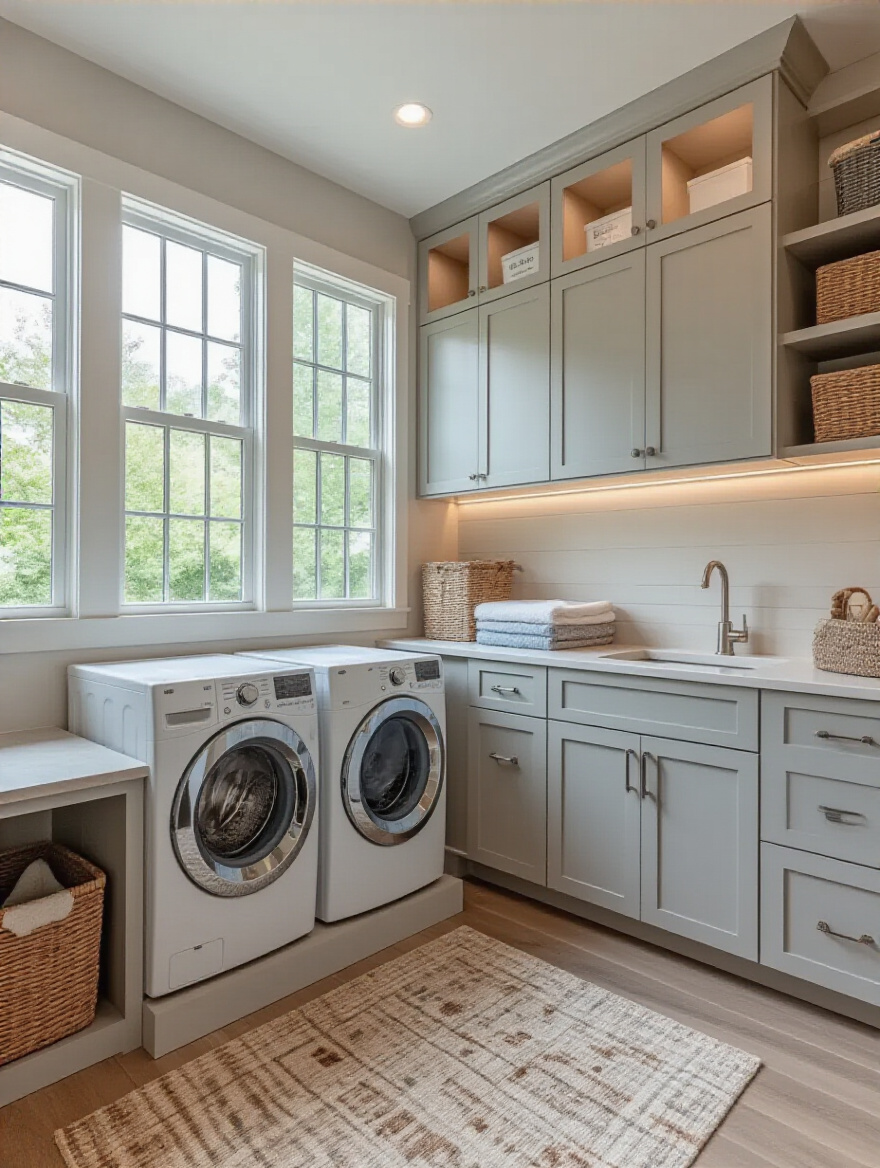
The BS is thinking you can just shove a desk in there and call it an office. The shortcut is to think about what activities support your social life. I had a client integrate a small, secondary beverage fridge and a deep utility sink into their laundry room, which was right off their patio. Suddenly, it became the perfect staging area for outdoor parties, keeping the main kitchen traffic-free. Don’t just add functions; choose secondary roles that make hosting easier and keep clutter away from your guests.
This isn’t about making the room do more; it’s about making it do more for you.
3. Assess Plumbing & Electrical Needs for Future-Proofing
Here’s a confession: early in my career, I designed this stunning media room for a client. We were so focused on the AV that we overlooked the power needs of the adjoining utility room. He bought a new high-end steam dryer, plugged it in, and promptly blew the circuit for the entire entertainment system right in the middle of a movie night. It was a disaster, and I learned a hard lesson that day: your infrastructure is everything.
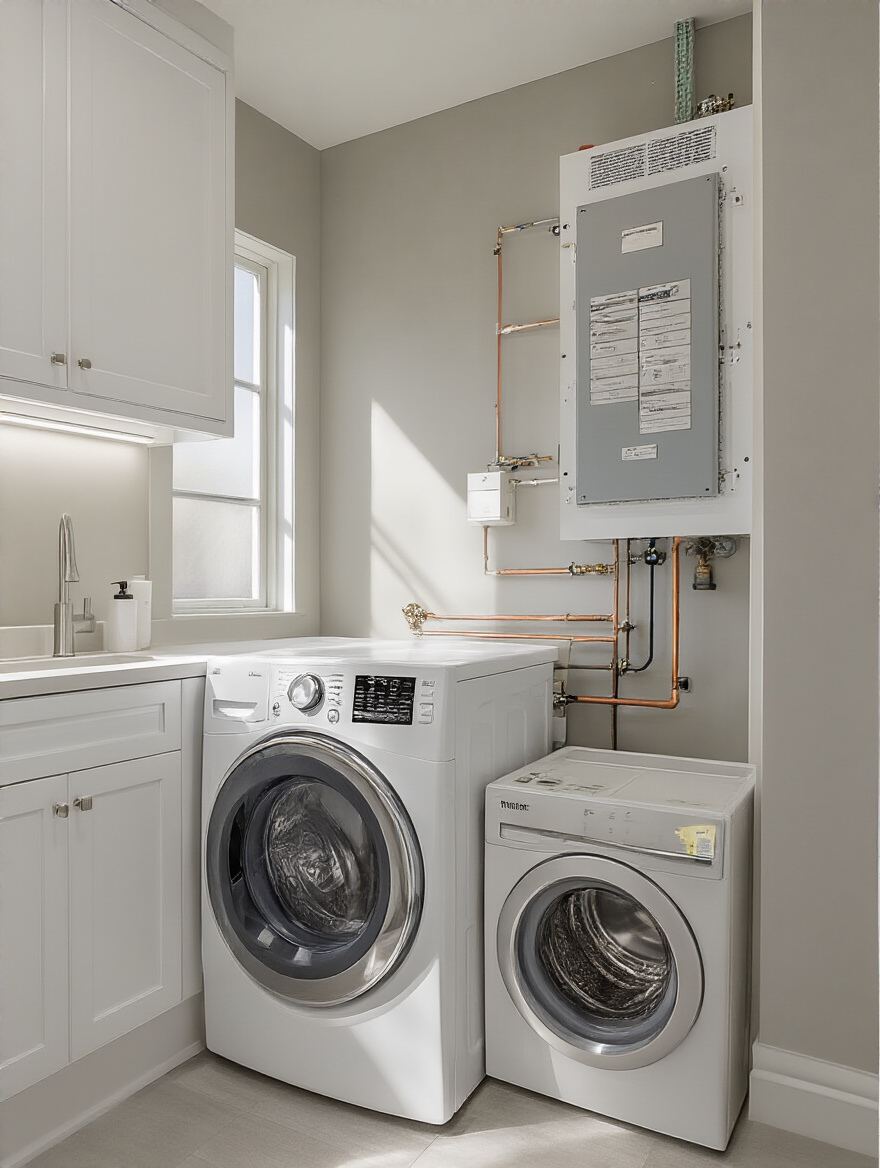
You have to think of your plumbing and electrical as the power grid for your home’s backstage. You wouldn’t run a state-of-the-art server on a single extension cord, so don’t run your high-tech appliances on 50-year-old wiring. Getting a licensed electrician and plumber to assess your setup is non-negotiable. The BS is thinking that “if the outlet fits, it works.” The real story is that modern appliances, especially those with steam functions or smart tech, have specific power demands.
Future-proofing now by adding a dedicated 240V outlet or upgrading water lines will save you thousands in emergency repairs later.
4. Measure Accurately for Custom Cabinetry & Appliance Fit
Can we talk about why people think they can just eyeball measurements? It drives me insane. You wouldn’t buy a 75-inch TV for a media cabinet designed for a 65-inch screen. The same laser-like precision applies here. One quarter-inch can be the difference between a seamless, integrated look and a disaster that requires you to send back $5,000 worth of custom cabinets.
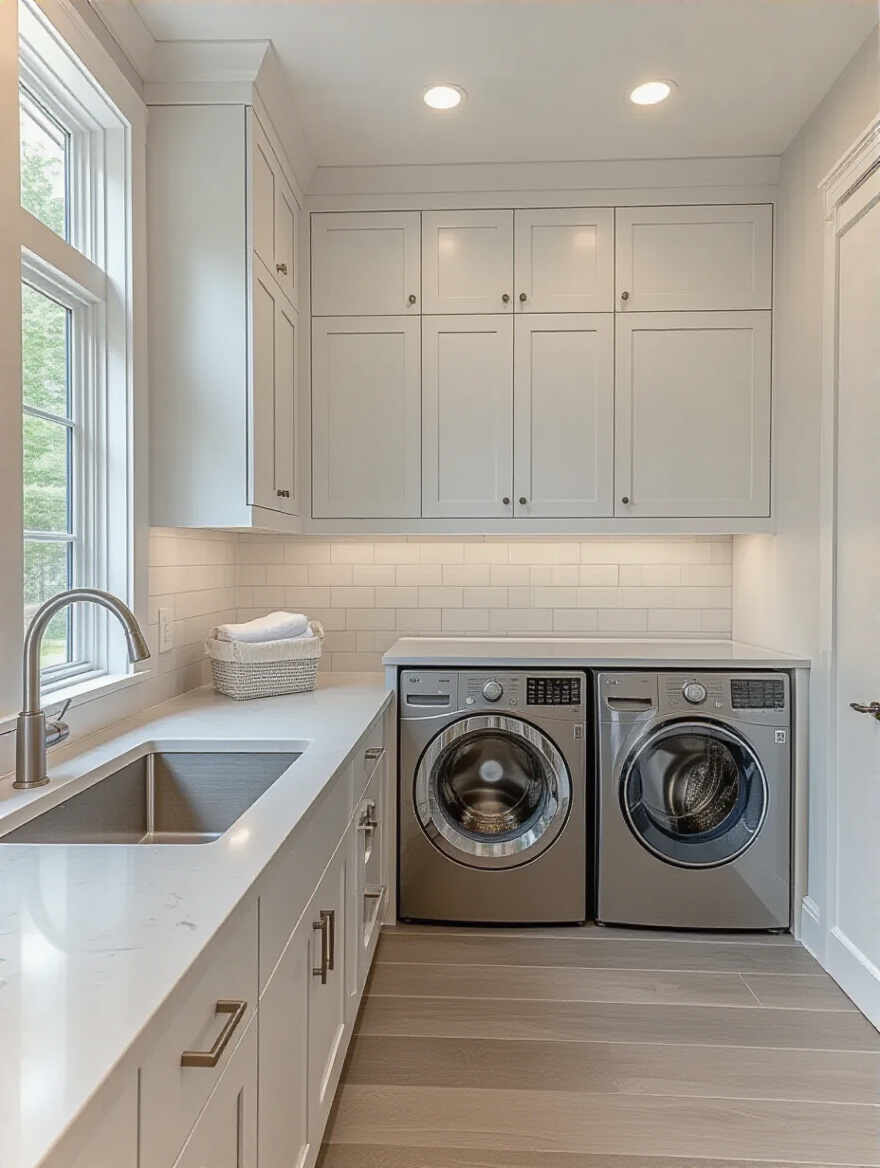
What actually matters is measuring everything—three times. Width, depth, height, yes, but also the swing of the appliance door, the location of the outlets, the unevenness of the floor. Everyone says, “Oh, it’ll fit.” The reality is that walls are rarely perfectly straight, and spec sheets don’t account for the quarter-round trim your builder installed. The shortcut? Use a laser measure and take pictures of your measurements so you can reference them on your phone while shopping. This isn’t just about fit; it’s about airflow and utility access, which are critical for appliance performance and longevity.
Don’t let a lazy measurement ruin a brilliant design.
Smart Planning & Space Optimization Foundations (Part 2)
Okay, you’ve got your layout and your power grid sorted. Now we need to talk about the environment itself. The best entertainment spaces have excellent climate control and air quality. The laundry room is no different. It’s a high-humidity, high-lint zone, and if you don’t manage that, it will negatively impact the rest of your home.
5. Prioritize Ventilation Solutions to Prevent Humidity Issues
Let’s be honest: nobody likes walking into a house that smells vaguely damp. A laundry room without proper ventilation is basically a moisture factory pumping humid, stale air throughout your home. This isn’t just about preventing musty smells; it’s about protecting your home’s structure from mold and mildew and keeping your air quality pristine for your family and guests.
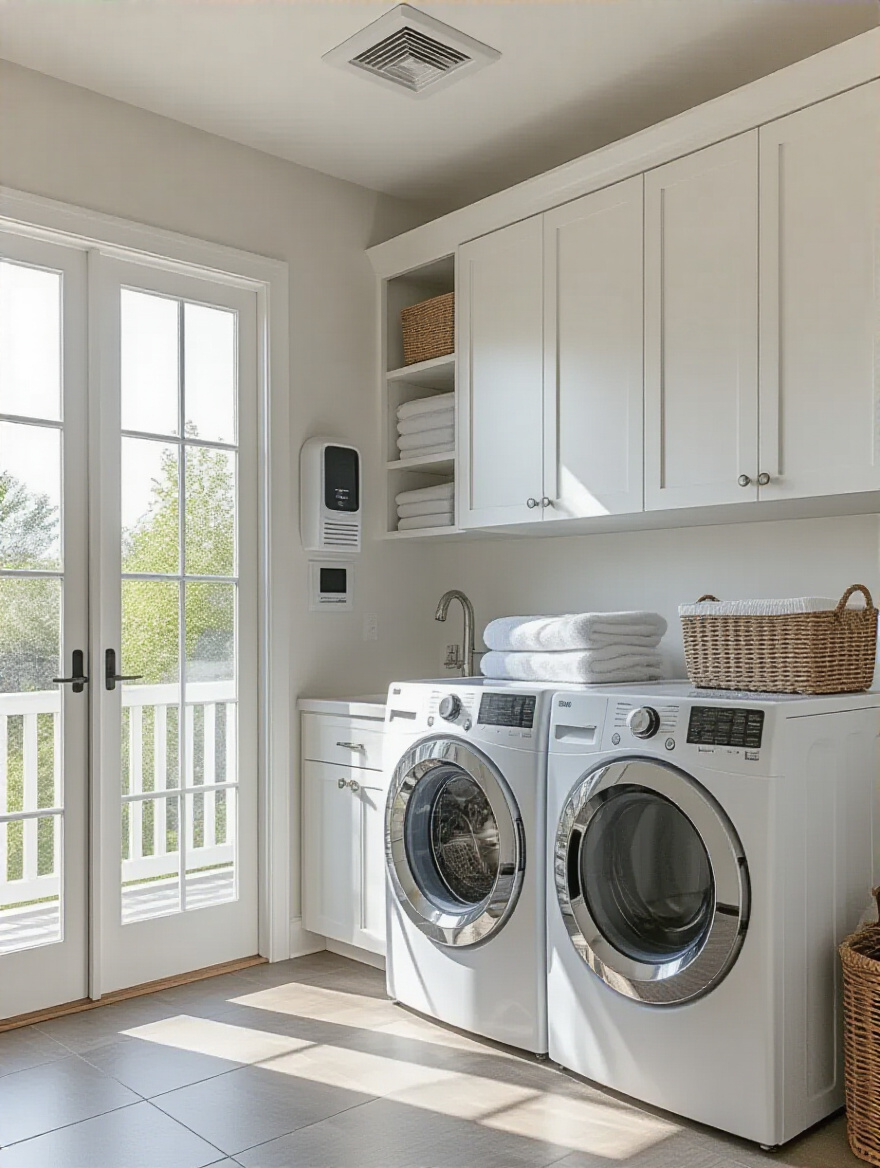
You absolutely need a high-quality exhaust fan that vents directly outside. Not into the attic, not into a crawlspace. Outside. I once consulted on a home where the builder vented the laundry room fan into the ceiling cavity. Over five years, it created a massive mold problem that cost over $10,000 to remediate. Proper ventilation is the cooling system for your utility hub. It removes the excess heat and moisture that can damage your home and your health over time, ensuring the air in your party spaces stays fresh and clean.
Don’t cheap out on this. A good fan with a humidistat that turns on automatically is a smart investment that works silently in the background to protect your biggest asset.
Strategic Appliance & Layout Implementation (Part 1)
Now for the fun stuff—the hardware. Choosing the right appliances and placing them correctly is like picking the components for a killer sound system. The quality of each piece and how they work together determines the overall performance. This is where you can make choices that save you time, energy, and money.
6. Choose Energy-Efficient Washer & Dryer Models
People see the ENERGY STAR label and think, “Oh, that’s just for environmentalists.” That’s total BS. What it really means is that the appliance is engineered with smarter, quieter, and more efficient technology. An old, clunky washing machine that sounds like a jet engine taking off during the spin cycle is the last thing you want rattling through the walls while you’re trying to host a dinner party.
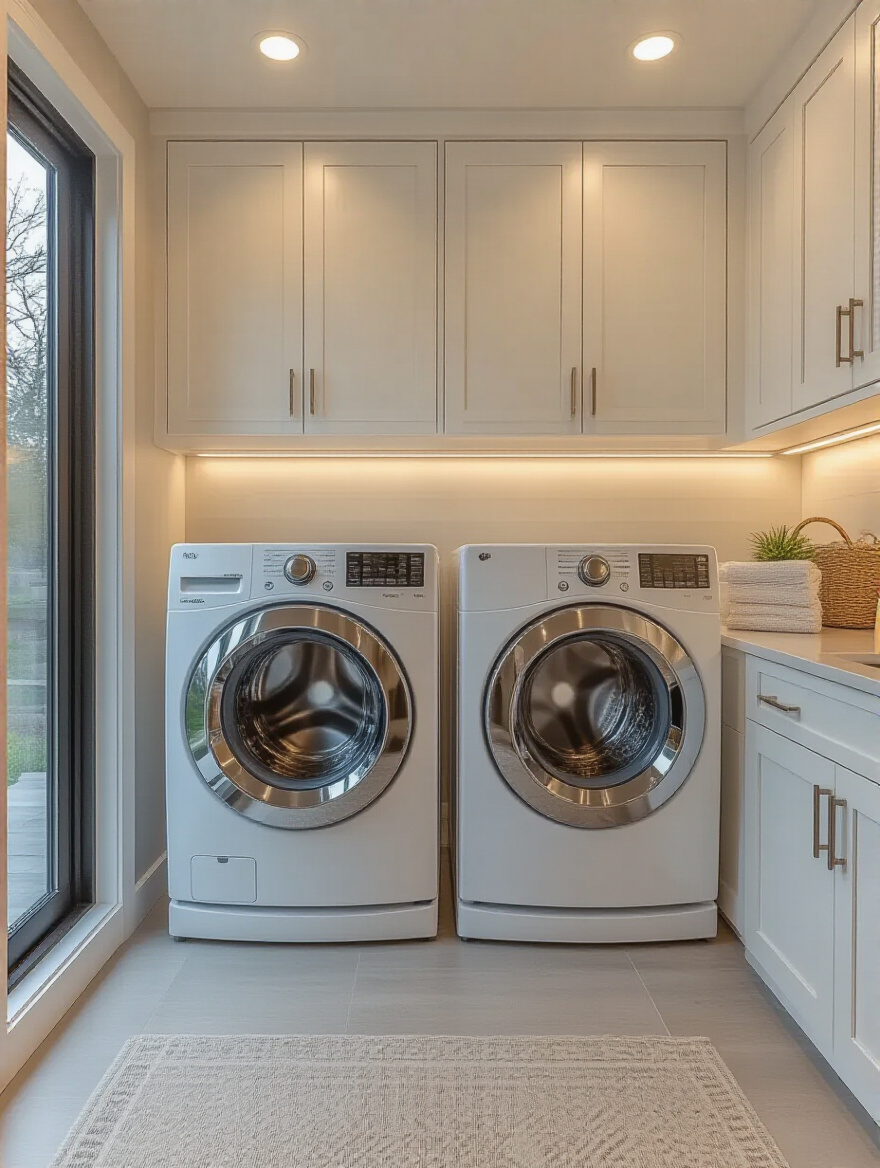
Modern energy-efficient machines aren’t just about saving a few bucks on your utility bill. They often come with smart features that connect to your Wi-Fi, have quieter direct-drive motors, and use advanced sensors to treat your clothes more gently, making them last longer. I always tell clients to look for a machine’s decibel rating. A quiet appliance is a foundational element of a serene home, and that’s a key component of great hospitality. Think of it as investing in tech that does its job brilliantly, but silently.
So yes, you’ll save money and the planet, but the real win is getting powerful performance without the disruptive noise.
7. Opt for Stackable vs. Side-by-Side Configurations
This is a classic debate, but it’s simpler than you think. This is your system architecture. Are you building a compact, vertical tower, or a sprawling horizontal array? Stacking your washer and dryer is the ultimate space-saver, freeing up valuable floor space for a folding counter, a utility sink, or even a small beverage station—a huge win for social hosts. The trade-off is that you lose the long, continuous countertop you get with a side-by-side setup.

Neither is universally better; the right choice depends entirely on your room’s layout and your workflow. My advice is to think about your “user interface.” A side-by-side configuration with a beautiful countertop over it creates an amazing workstation for folding and sorting. But if your space is tight, a stacked unit can open up the room for other functions that make hosting easier. For me, the game-changer is often the extra space a stacked unit provides for something like a dedicated dog-washing station or extra pantry storage.
It’s a strategic choice between maximizing floor space versus maximizing surface area.
8. Incorporate a Durable Countertop for Folding & Sorting
If you go with a side-by-side setup, your countertop isn’t just a surface—it’s your primary workstation. This is where you’ll fold clothes, treat stains, and sort everything. It needs to be tough as nails. The biggest mistake people make is choosing a material that can’t handle the abuse, like a cheap laminate that will swell and peel the first time a bottle of detergent spills on it.
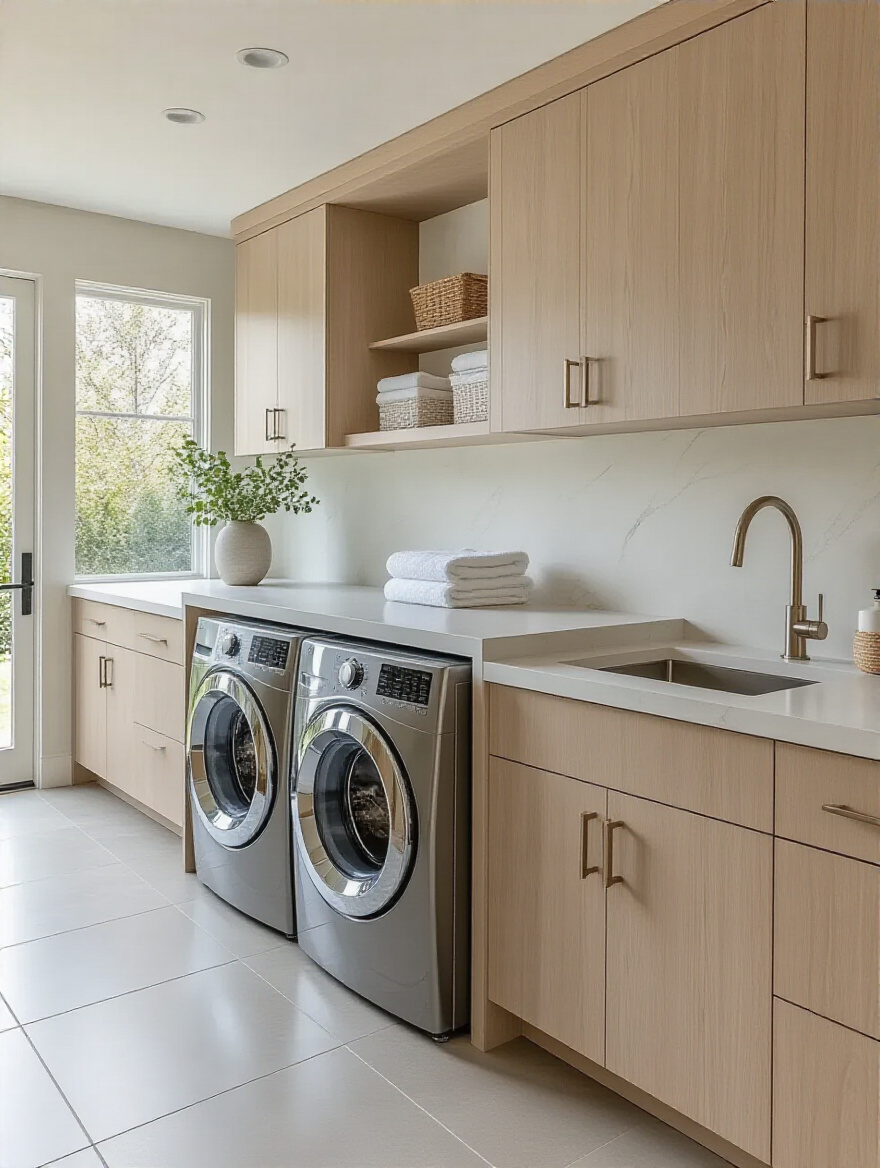
Think of this counter like the bar top in your entertainment room. It needs to be waterproof, stain-resistant, and easy to clean. Quartz is my go-to recommendation. It’s practically indestructible and looks fantastic. A sealed butcher block can also add warmth, but it requires more maintenance. Whatever you choose, make sure it’s installed at a comfortable, ergonomic height (usually 36-40 inches). Bending over a low surface is a recipe for back pain and makes chores feel even worse.
This is a place to invest in quality. A great countertop makes the whole space more functional and feel incredibly premium.
9. Integrate a Utility Sink for Pre-Treatment & Handwashing
A utility sink is the unsung hero of any truly functional home. It’s your “maintenance port,” the dedicated spot for handling all the messy jobs you don’t want contaminating your kitchen sink. For a host, it’s absolutely essential. This is where you’ll rinse out the red wine spill, handwash delicate napkins after a dinner party, or even fill a bucket to mop the floor after things get a little wild.
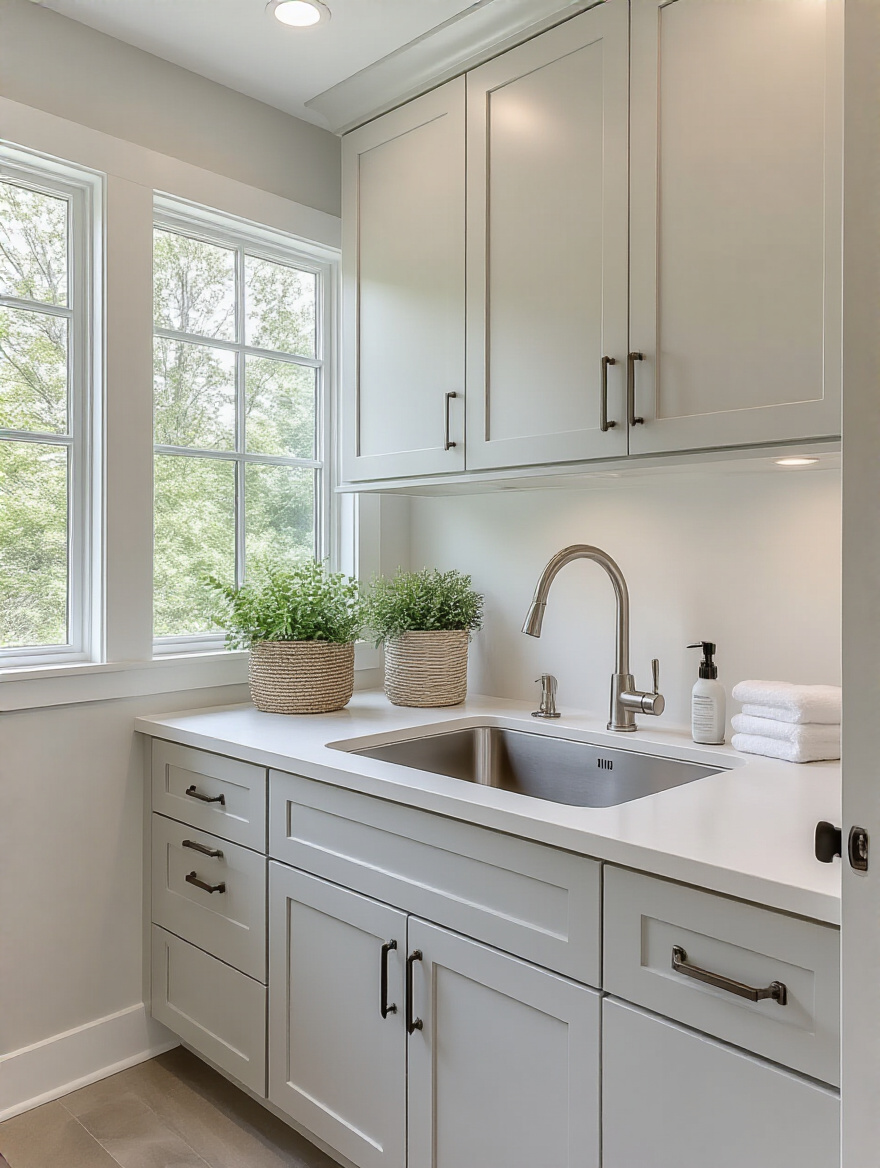
I learned this the hard way at one of my own parties. A guest tried to be helpful and rinse a greasy pan in my powder room sink, which was not equipped to handle it. A deep, robust utility sink in the laundry room would have saved the day. Don’t just get any sink; get a deep one with a high-arc faucet and a pull-down sprayer. It gives you the flexibility to wash anything from a muddy boot to a large flower vase.
This single feature will save your other sinks from abuse and make cleanup infinitely easier.
Strategic Appliance & Layout Implementation (Part 2)
We’ve covered the heavy machinery and core layout. Now let’s dial in the features that elevate the space from a simple utility room to a high-performance workspace. These are the thoughtful touches that streamline the final—and most-often-skipped—steps of the laundry process.
10. Design a Dedicated Drying Area: Rack, Rod, or Wall-Mounted
Everyone I know has that one chair in their bedroom that’s permanently covered in clothes that are “air-drying.” Let’s end this madness. Integrating a dedicated drying area into your laundry room isn’t just for delicates; it’s for athletic wear, expensive sweaters, and anything you don’t want to shrink in the dryer. For social hosts, it’s also a thoughtful touch for overnight guests who might need to wash something.
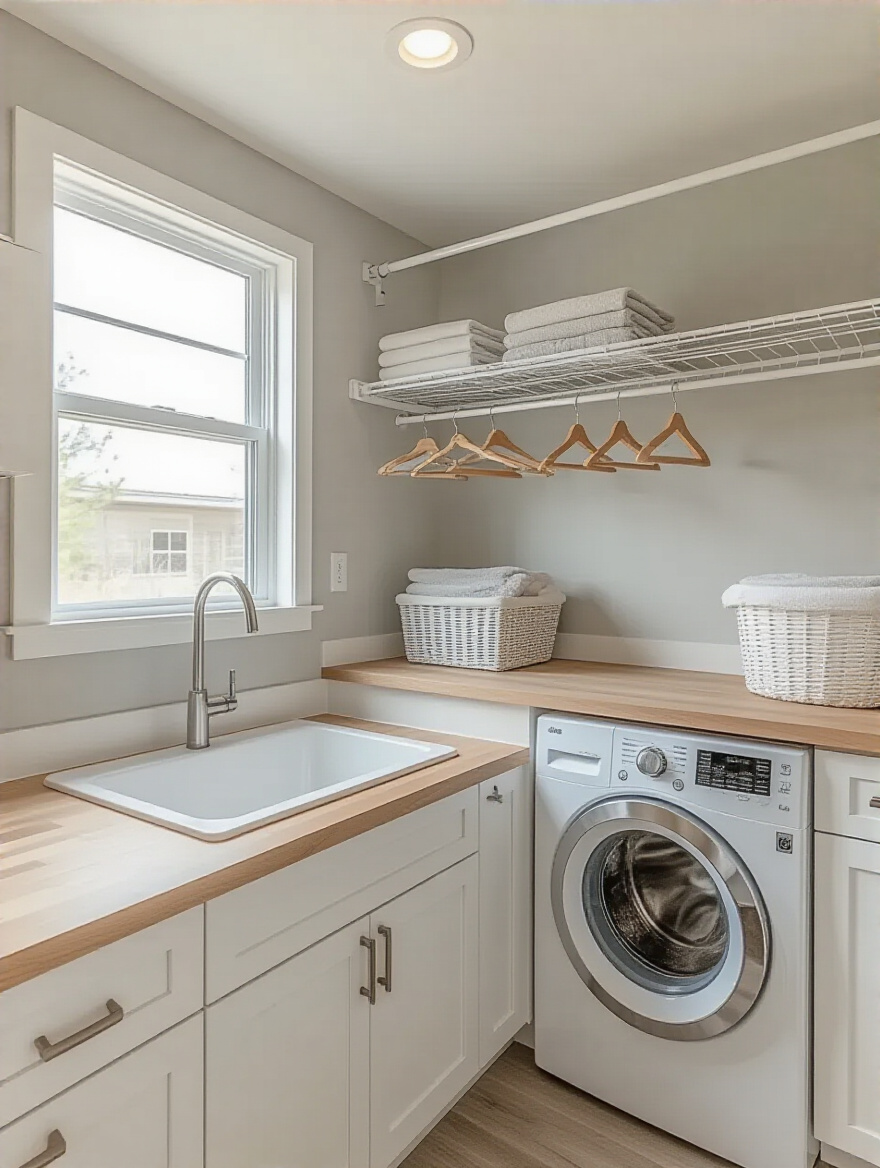
You don’t need a ton of space. There are so many slick solutions now, from retractable clotheslines that disappear when not in use to sleek, wall-mounted racks that fold flat. I’m a huge fan of ceiling-mounted pulley systems in rooms with high ceilings; they use vertical space brilliantly. Having this built-in functionality keeps your living spaces clear of clutter and makes you look like a hospitality genius.
This small addition dramatically improves the room’s functionality and shows a level of forethought that separates good design from great design.
11. Install Proper Lighting: Task and Ambient Illumination
You would never design a home theater with a single, bare lightbulb in the ceiling, right? So why do we tolerate it in the laundry room? Proper lighting is just as critical here as it is in any other space. You need layered lighting: bright, ambient overhead light to illuminate the whole room, and focused task lighting directly over your work surfaces.
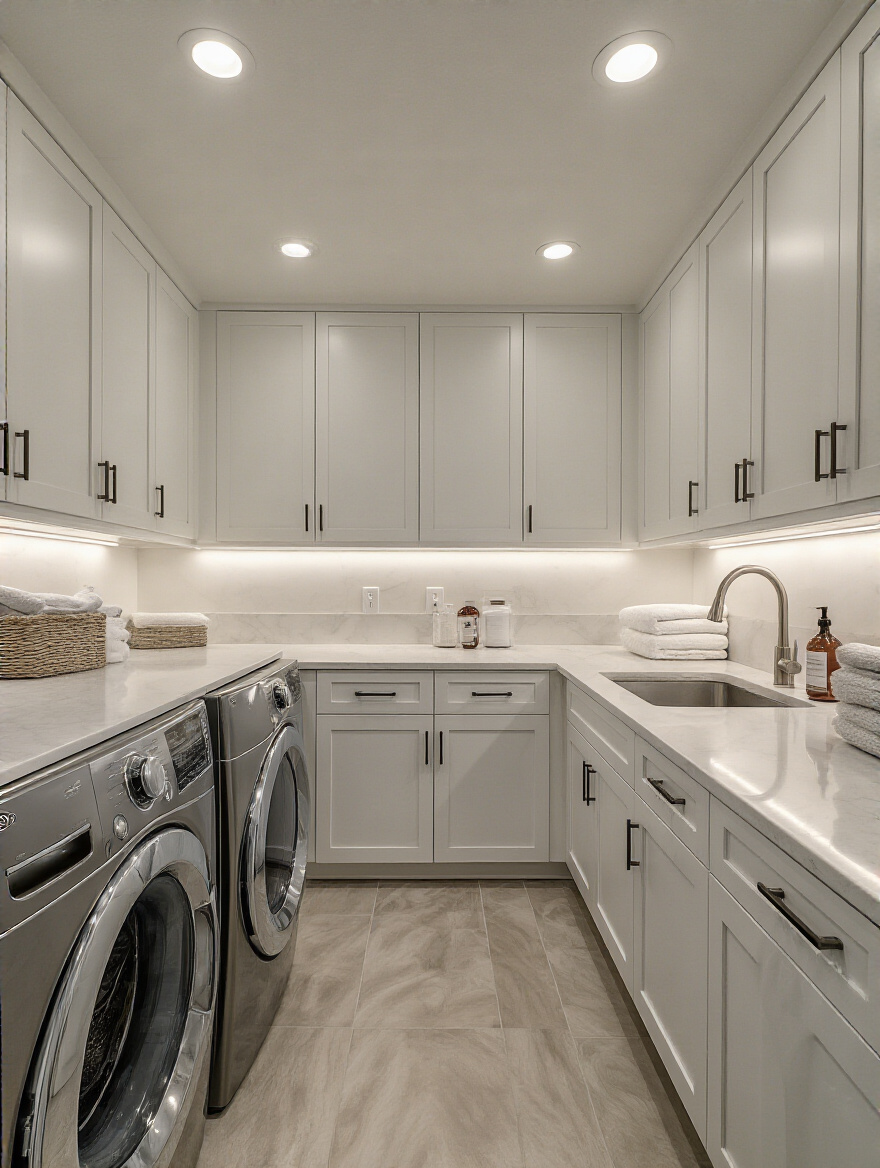
The biggest mistake is thinking one fixture is enough. It creates shadows, making it impossible to see if that stain really came out or if you’re matching navy blue or black socks. I always install LED strips under the upper cabinets to light up the countertop. It’s a cheap upgrade that makes the room feel high-end and dramatically improves visibility. And put everything on a dimmer. That way, you can have bright, clear light when you’re working, and a soft, ambient glow when you’re just passing through.
Good lighting makes any task more pleasant and any room more inviting. Period.
Maximizing Storage & Elevating Aesthetics (Part 1)
Clutter is the enemy of a great space. In a utility room, it’s also the enemy of efficiency. This is where we bring order to the chaos. Smart storage isn’t just about hiding things; it’s about making everything you need accessible, organized, and easy to find, all while looking damn good.
12. Utilize Vertical Storage with Tall Cabinets & Open Shelving
Most laundry rooms have a ton of wasted space between the top of the appliances and the ceiling. Using this vertical real estate is the number one shortcut to a clutter-free room. Think of it like installing server racks in a data center—you want to maximize the storage density. A mix of tall, closed cabinets and open shelving is the perfect combo.
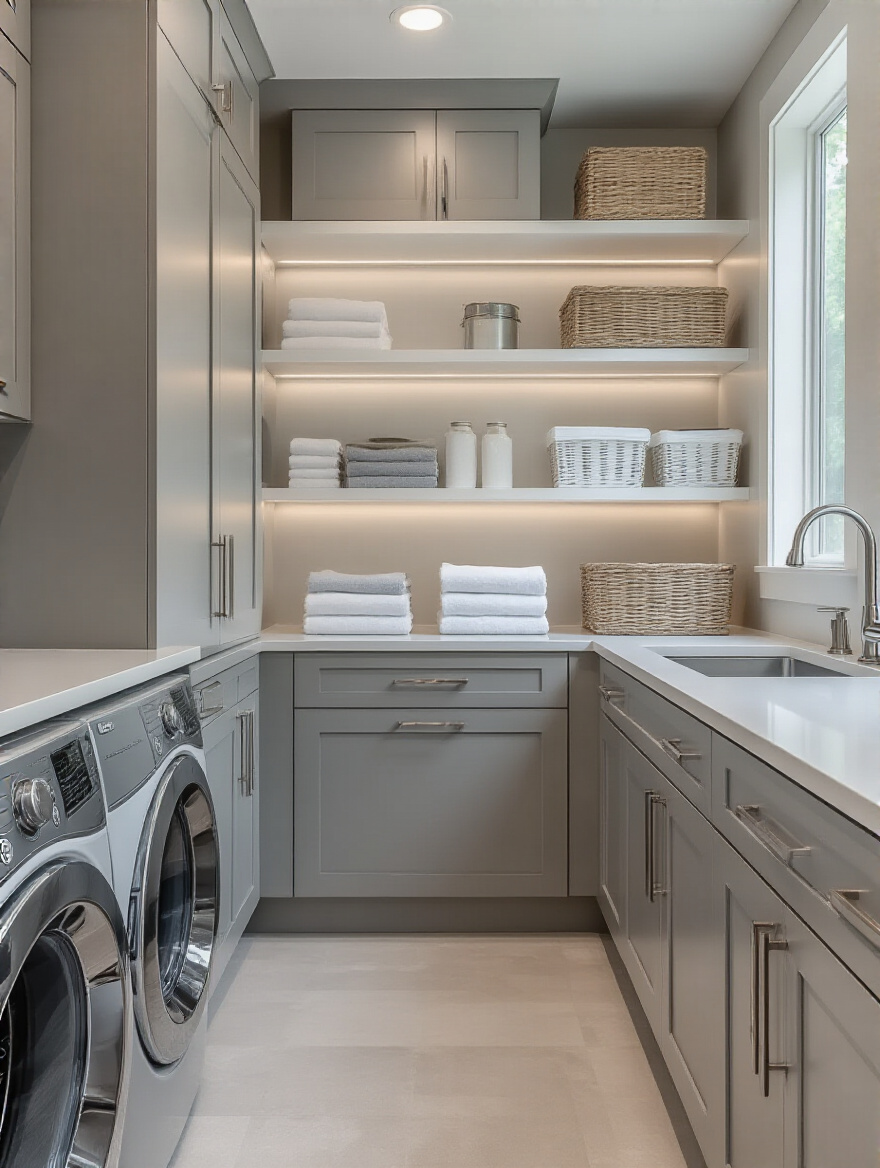
Closed cabinets are for hiding the ugly stuff: bulk detergent bottles, cleaning supplies, and all the miscellaneous junk that ends up in there. Open shelving is for the things you need to grab quickly and for adding a touch of style. Use beautiful baskets or clear glass jars for detergent pods and dryer sheets. It’s functional and decorative. Just don’t make the rookie mistake of putting heavy liquid detergent containers on a high shelf. Keep heavy items low and lighter, frequently used items at eye level.
Going vertical is the fastest way to double your storage without increasing your footprint.
13. Implement Built-In Hamper & Sorting Systems
Visible piles of dirty laundry are a vibe killer. A built-in hamper system is the solution. This is a game-changer. Imagine cabinetry with pull-out or tilt-out bins—one for whites, one for darks, one for delicates. The laundry gets pre-sorted as it comes in, which saves you a massive step on laundry day. And most importantly, it’s all hidden from sight.
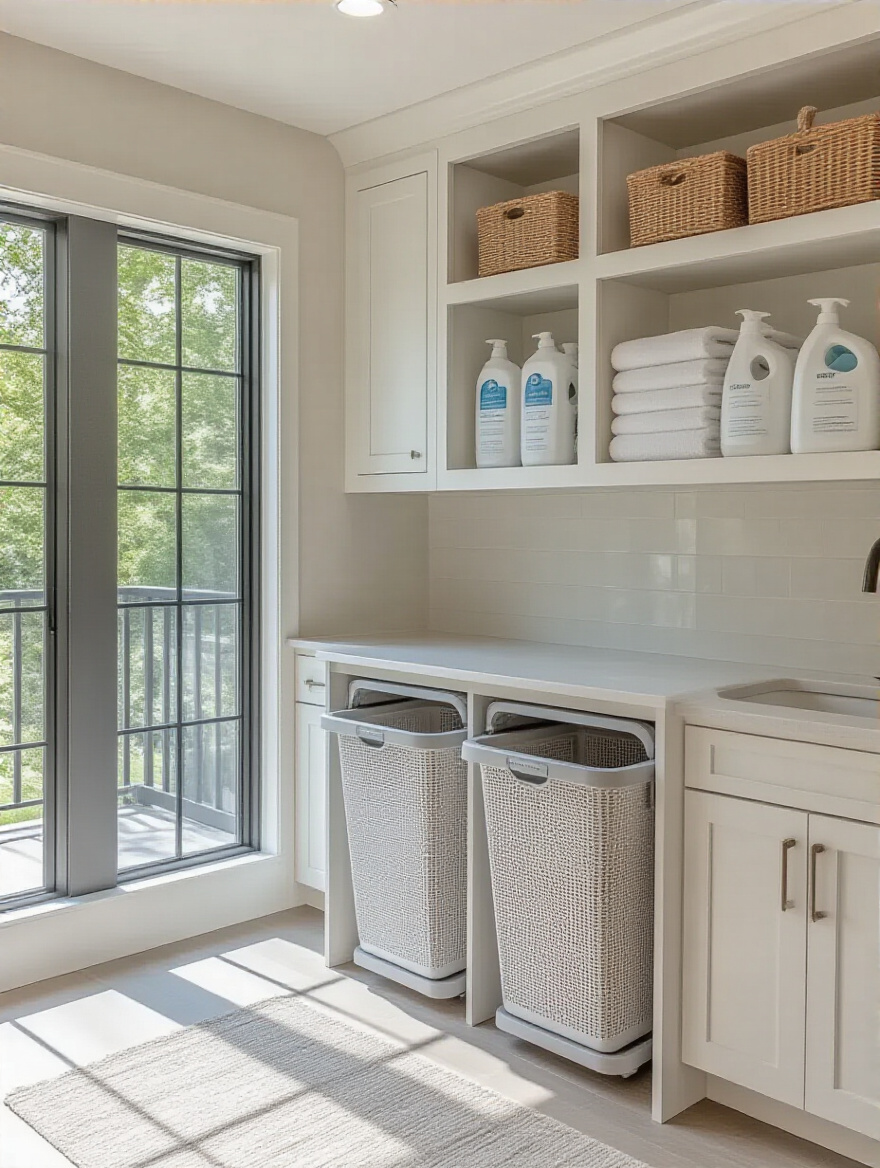
This is what I call “integrated data sorting.” You’re building the organizational logic directly into the hardware of the room. It’s one of those elegant solutions that makes life easier and your space look infinitely cleaner. I once installed a three-bin tilt-out system for a family of five, and the mom told me it was the single best thing we did in the entire house renovation. It completely eliminated the “floordrobe” problem in her kids’ rooms.
This is how you move from a reactive clean-up process to a proactive, organized system.
14. Select Easy-to-Clean, Moisture-Resistant Flooring
Flooring in a laundry room has one primary job: to be completely bulletproof against water. This is non-negotiable. I’ve seen way too many catastrophes caused by people putting the wrong flooring material in a wet zone. Hardwood, carpet, and standard laminate are all ticking time bombs in a laundry room. A small leak from a hose can turn into a five-figure repair job.
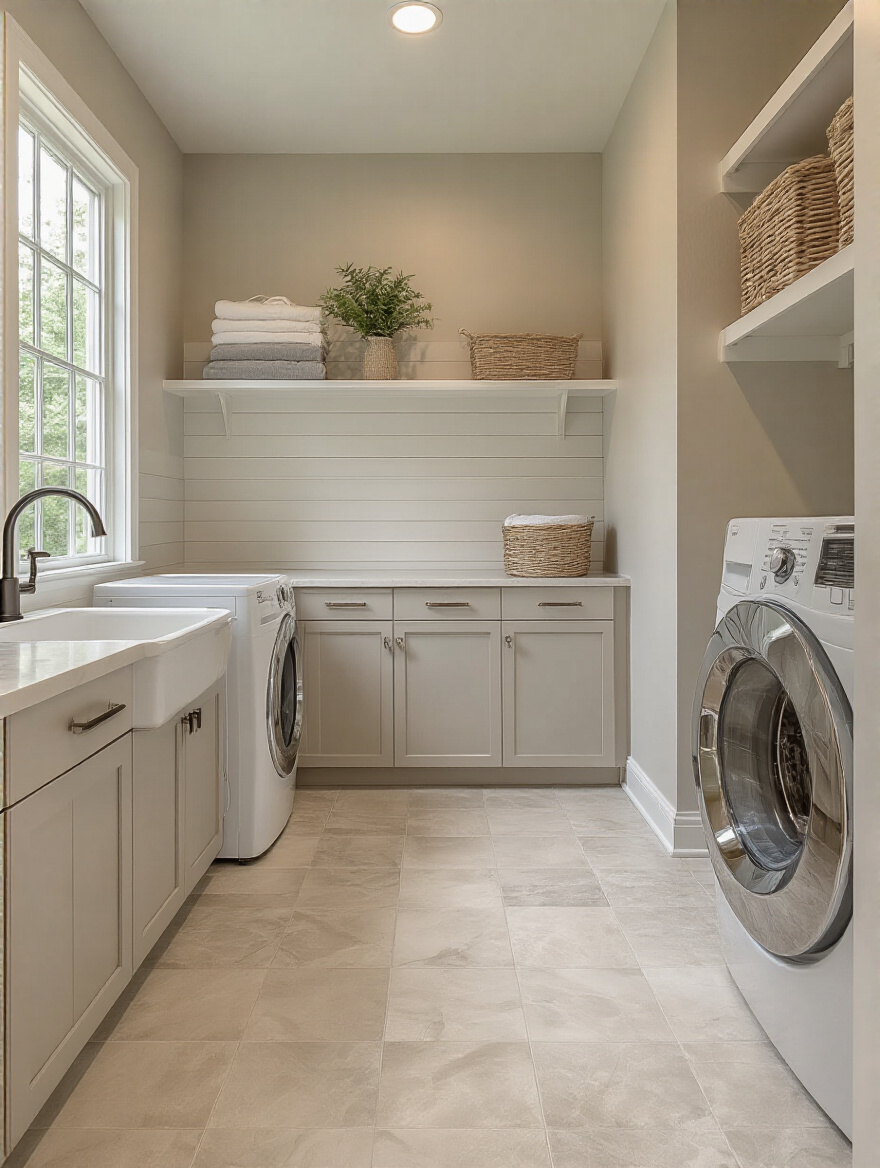
Luxury vinyl plank (LVP) or porcelain tile are your best bets. They are 100% waterproof, incredibly durable, and easy to clean. If you go with tile, use a dark grout or an epoxy grout that resists staining. And here’s a pro tip I wish everyone knew: consider installing a floor drain. It’s a small additional cost during a renovation, but it’s the ultimate insurance policy against a catastrophic flood. It provides total peace of mind, especially if your laundry room is on an upper floor.
Don’t mess around here. Function absolutely must come before form.
15. Introduce Splashbacks & Wall Treatments for Style and Protection
Just like in a kitchen, a backsplash behind your utility sink and countertop area is both functional and a fantastic design opportunity. It protects your drywall from water splashes and detergent spills, making cleanup a breeze. But it’s also a place where you can inject a ton of personality into an otherwise boring room.
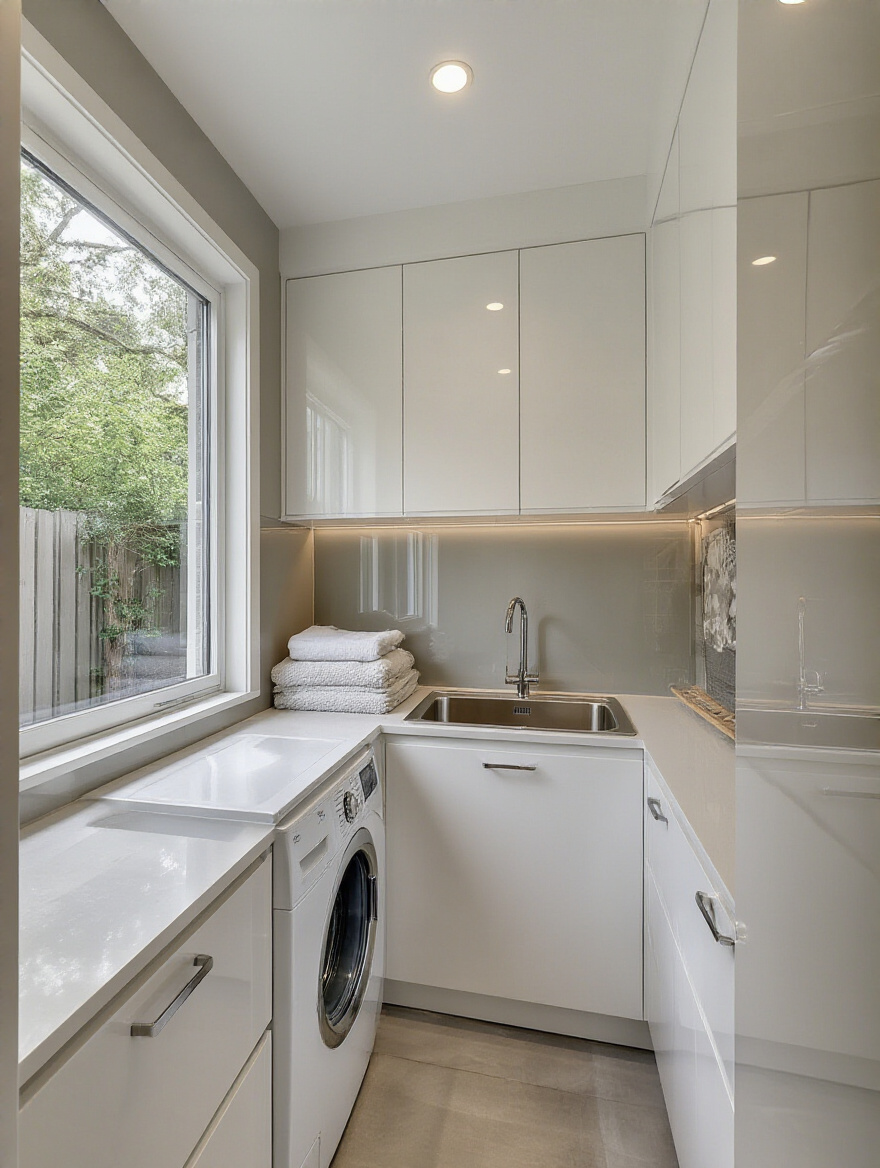
This is the perfect place to use that bold, patterned tile you love but were too afraid to use in your kitchen. Because the area is small, you can splurge on a high-end material without breaking the bank. Things like ceramic tile, glass panels, or even durable, moisture-resistant wallpaper can completely transform the look and feel of the room. It turns a purely utilitarian wall into a design feature that makes the whole space feel more intentional and upscale.
It’s a small touch that delivers a huge aesthetic and protective impact.
Maximizing Storage & Elevating Aesthetics (Part 2)
Your laundry room is built. It’s functional, organized, and protected from the elements. Now, we get to add the personality. This is the “UI skin” that makes the space feel less like a sterile utility closet and more like a thoughtful extension of your home.
16. Add Decor Elements & Personal Touches for Ambiance
Why should a laundry room have to look like a sterile, joyless box? You spend a surprising amount of time in there, so you might as well make it a place you don’t hate being in. Adding art, a nice rug (make sure it’s washable!), or even a small plant can completely change the energy of the space.
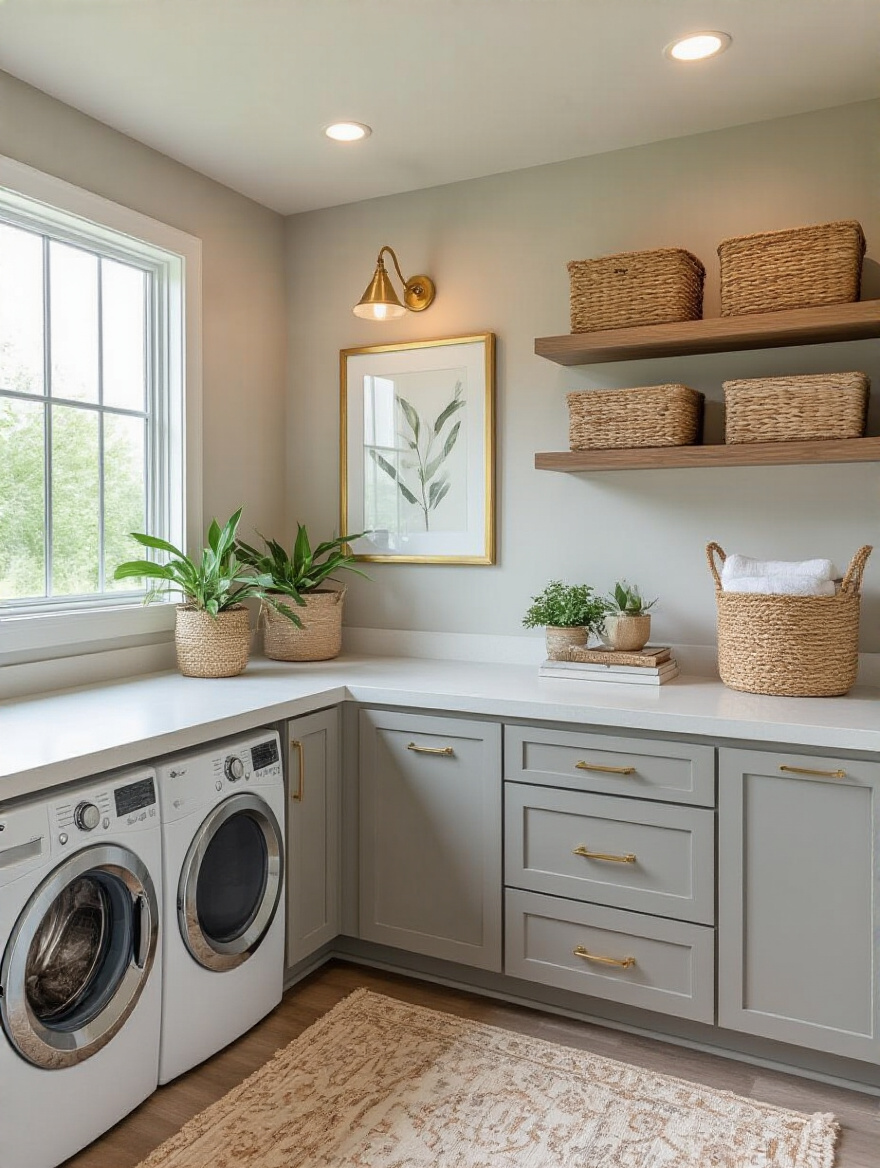
This is where you call out the BS that utility rooms have to be ugly. A simple framed print on the wall, stylish containers for supplies, or a cool light fixture can elevate the room instantly. A client of mine installed a small smart speaker and hung up some framed photos from family trips. She told me it completely changed her attitude about doing laundry; she puts on a podcast and it becomes a moment of peace instead of a dreaded chore. This isn’t about cluttering the space; it’s about a few well-chosen items that make it feel human.
Good design should extend to every room in your house, including this one.
Smart Organization, Maintenance & Advanced Solutions
We’ve covered the design, now let’s talk about the tech and upkeep. This is where we truly upgrade the room from a passive space to an active, intelligent system that makes your life easier and protects your home. These are the advanced solutions that really deliver on the promise of a modern home.
17. Integrate Smart Home Laundry Appliances for Convenience
Okay, now we’re in my wheelhouse. Smart appliances are no longer a gimmick. The ability to start, stop, and monitor your laundry from your phone is a legitimate time-saver. You get a notification when the cycle is done, so clothes don’t sit in the washer getting musty for hours. You can download custom cycles for specific items, and some machines will even automatically order more detergent when you’re running low.
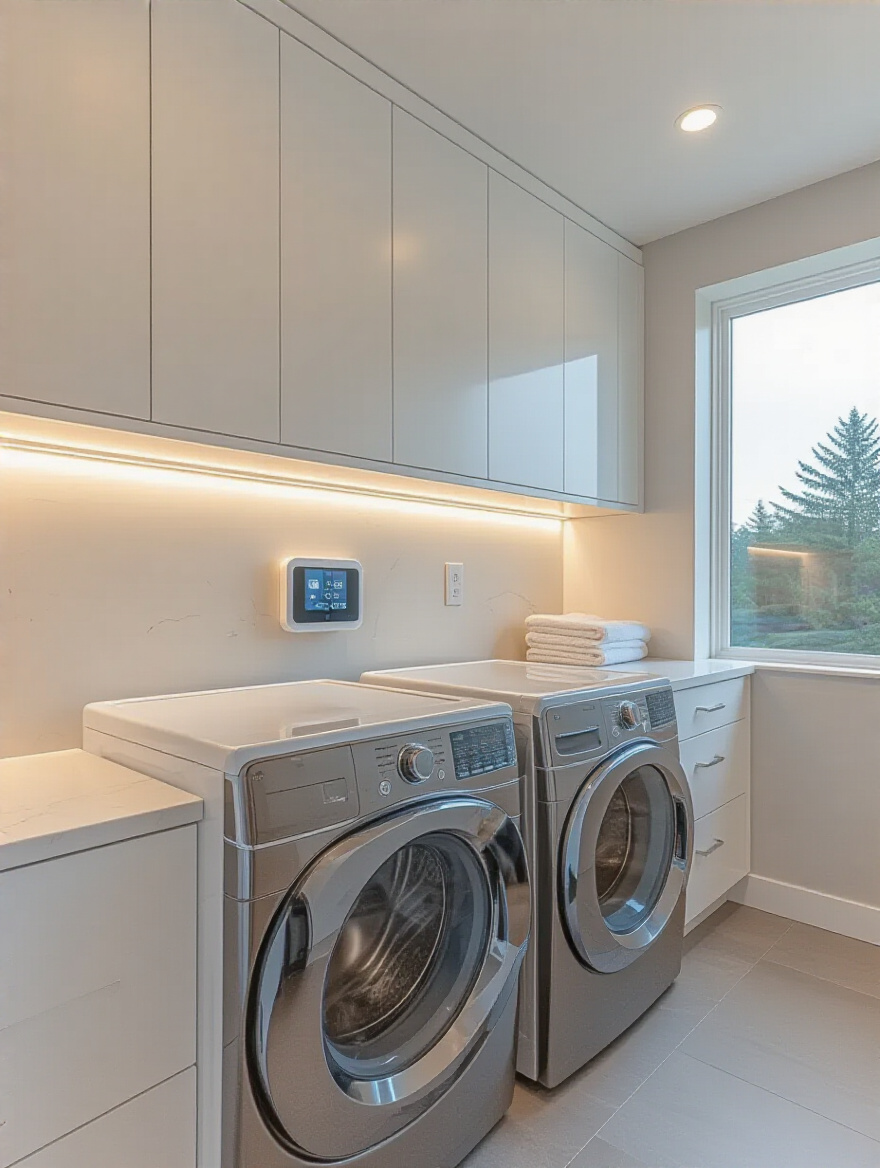
The real next-level move is integrating it with your smart home ecosystem. I have a routine set up where when my dryer finishes, the smart lights in my kitchen and living room flash blue for a second. It’s an ambient notification that’s impossible to miss but doesn’t involve a jarring alarm. This tech buys you back time and mental energy—the two most valuable resources for any host.
This is about using technology to automate the mundane so you can focus on the meaningful.
18. Create a DIY Detergent Dispensing & Storage Station
Let’s banish those giant, sticky, plastic detergent jugs forever. A DIY dispensing station is one of the easiest and most satisfying upgrades you can make. Get a set of beautiful glass or plastic beverage dispensers for your liquid detergents and fabric softeners, and matching airtight canisters for powders and pods. It instantly makes your space look organized, clean, and incredibly chic.
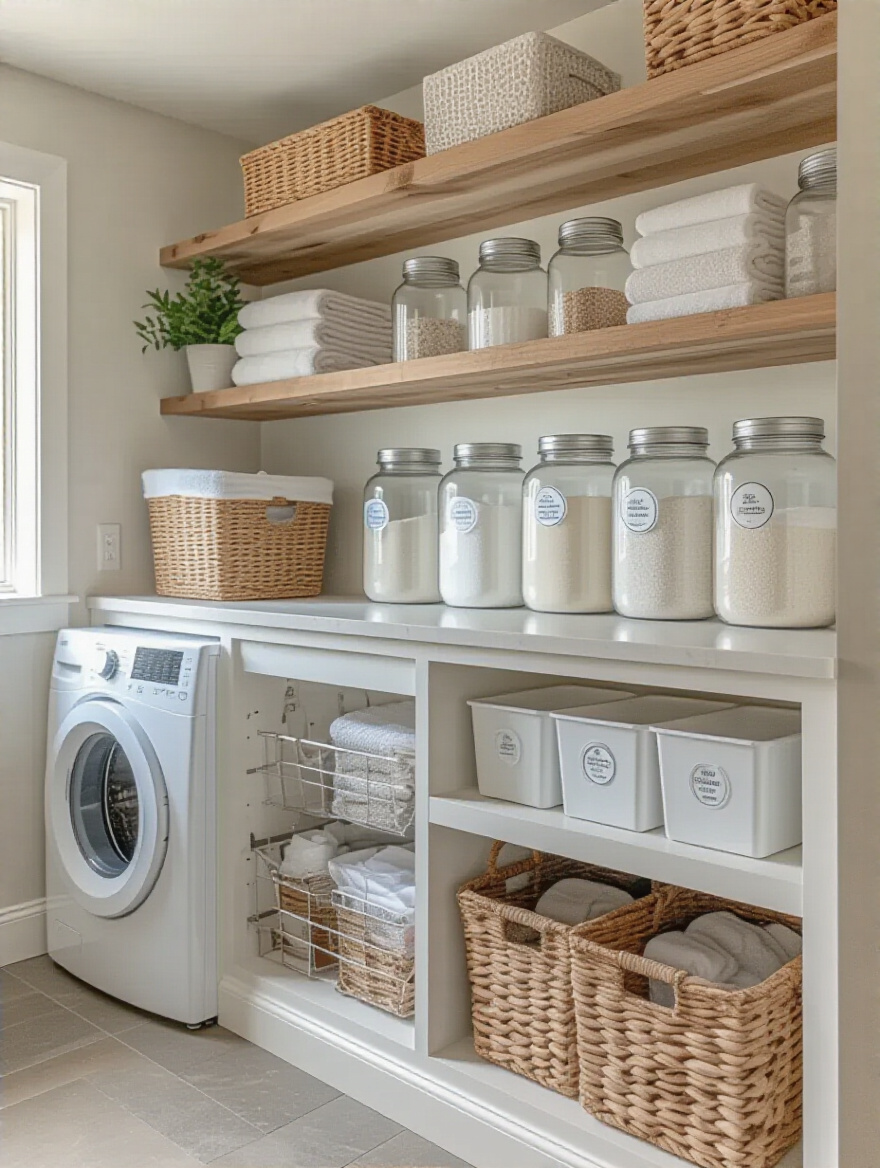
This isn’t just about looks. It’s far more practical. It’s easier to dispense a controlled amount, which prevents overuse and spills. And by buying your detergent in bulk (in those eco-friendly boxes), you save money and reduce plastic waste. Put everything on a riser so you can fit a measuring cup underneath the spigot. And label everything clearly. Trust me on that last part. You don’t want to mix up the bleach and the fabric softener.
It’s an elegant, functional solution that punches way above its weight in terms of impact.
19. Install an Automatic Water Shut-Off Valve for Safety
If you do nothing else on this list, do this. An automatic water shut-off valve is the single most important safety device for your laundry room. It’s a small sensor you place on the floor that, when it detects moisture, instantly triggers a valve on your water line to shut off the supply. It’s the ultimate fail-safe that can prevent a catastrophic flood.
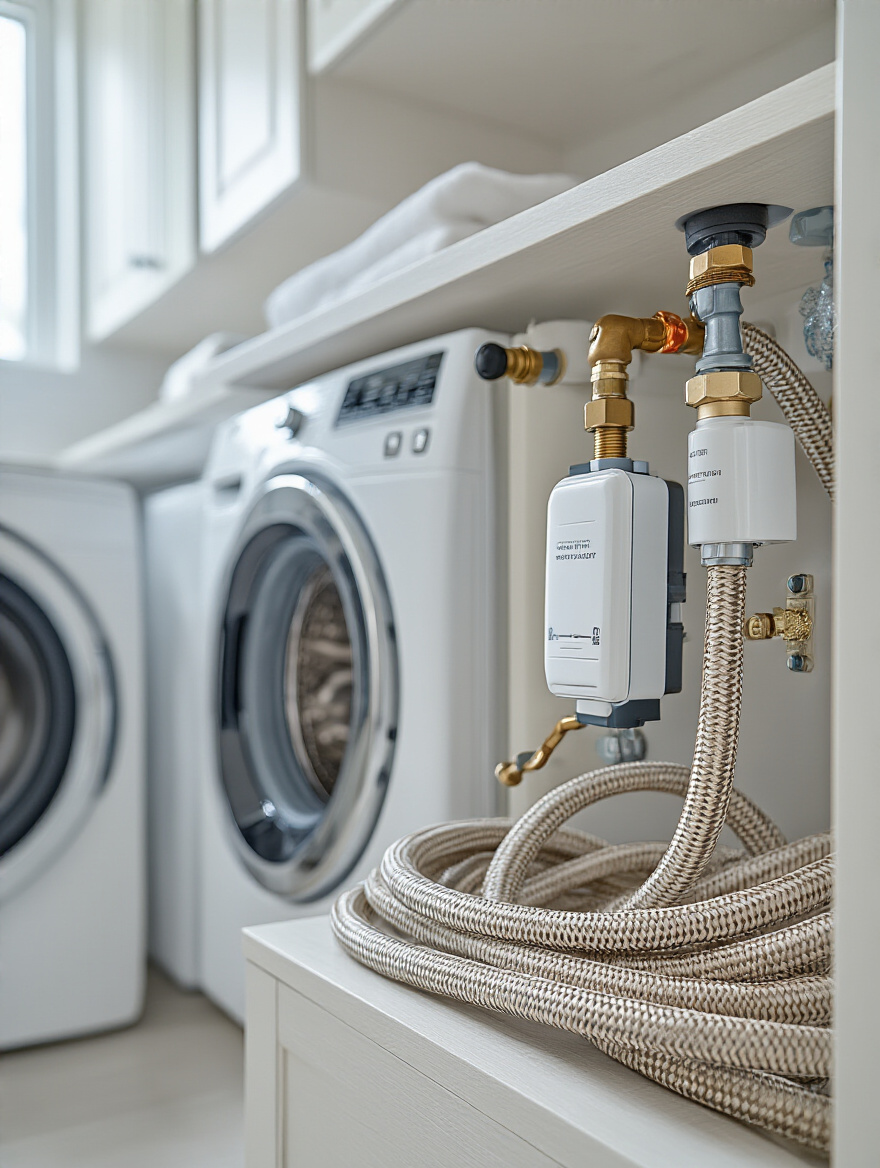
I have seen burst washing machine hoses cause more than $50,000 in damage in a matter of hours. This tiny, inexpensive device can protect your entire home. It’s like a surge protector for your plumbing. Modern smart versions will even send an alert to your phone. It’s an absolute no-brainer. Every single home should have one of these. It’s cheap insurance that can save you an unbelievable amount of money and heartache.
Don’t wait. Install one now.
20. Develop a Regular Appliance Cleaning & Maintenance Schedule
Finally, let’s talk about upkeep. Your washer and dryer are complex machines that need regular maintenance to run efficiently and safely. A clogged dryer vent is not just an efficiency issue; it’s one of the leading causes of house fires. You absolutely must clean your dryer vent ducting—the whole thing, from the back of the machine to the outside of your house—at least once a year.
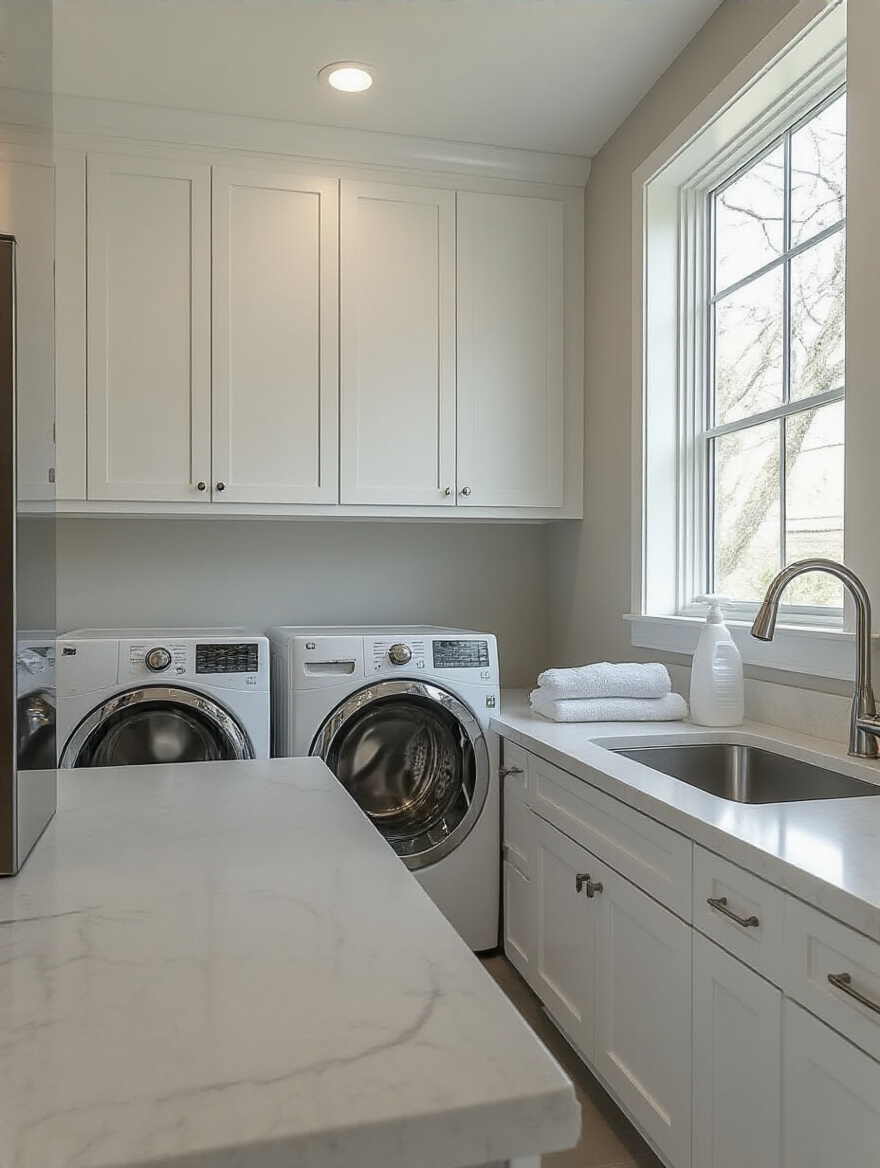
Create a simple schedule. Clean the washer’s lint trap and run a self-clean cycle with vinegar monthly. Check the water supply hoses for cracks or bulges quarterly. This is like running firmware updates and system diagnostics on your tech. It ensures peak performance, extends the lifespan of your expensive appliances, and prevents dangerous failures. It takes minutes a month but can save you thousands in the long run.
Think of it as protecting your investment and ensuring your home’s “backstage” is always ready for showtime.
Conclusion
So there you have it. Your laundry room doesn’t have to be a source of stress that detracts from the joy of bringing people together. By thinking of it as the mission control for your home’s hospitality, you can transform it into a powerful asset. It’s the seamless, silent system working in the background to make sure the main event—your life, your parties, your family time—goes off without a hitch.
A well-designed laundry room gives you back time, reduces stress, and protects your home. It’s a space that proves that thoughtful design and smart technology can elevate even the most mundane parts of our lives. So go ahead, give your home’s unsung hero the upgrade it deserves. You’ll be amazed at how much a smooth-running backstage can improve the whole show.
